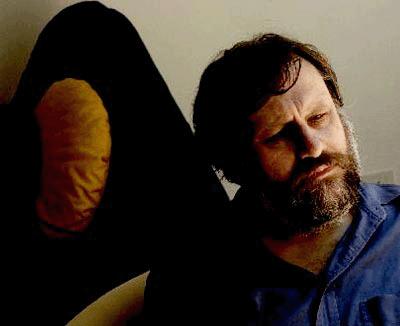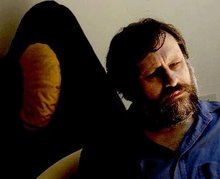Slavoj Žižek

ŽIŽEK RESOURCES
-------------------- [2007 - ]
-------------------- [2004 - 2006]
-------------------- [1989 - 2003]
-------------------- [2004 - 2007]
-------------------- [2001 - 2003]
-------------------- [1999 - 2000]
-------------------- [1994 - 1998]
-------------------- [1989 - 1993]
-------------------- Films And Documentaries
Links to Zizek-Related Weblogs/Sites
International Journal of Žižek Studies
-------------------- Contents (Vol 1, No 1, 2007)
-------------------- Žižek and Cinema
Miscellaneous - On Bolagrams, Mobius Strips, Lost Highway
Idiocies (including Zizek at MySpace)
Wednesday, January 3, 2007
Bolagrams and Lynch's Lost Highway
[2]
Critics either hold Lynch's Lost Highway to be a New Age mishmash of initiatory themes wheeling around an absurd critique of post-modern life, or they abandon critical hope in seeing the film as an exercise in noir excess -as James Naremore put it, "no other purpose than regression. . . another movie about movies." Slavoj Zizek has exhumed the serious and elegant stylistics behind the film to demonstrate that it is neither just an exercise nor a coded New Age manifesto but, rather, a coherent and consistent artistic account of our cultural condition. Not so coincidentally, Zizek's Lacanian insights correspond to bolagrammarian motions about an anamorphic center.This Möbius-band design constellates characters who are,without the underlying template, simply enigmatic.
House and shed
The house occupied by the couple we first meet (Fred and Renee Madison) is the best starting point. Fred hears a voice on the intercom, "Dick Laurent is dead,"but there is no one at the door, just a videotape that happens to show their house from the outside. The next morning, another videotape is left that shows the house's interior with the sleeping couple inside. The police are called in but can find no explanation.We learn that Fred is semi-impotent, and when he accompanies Renee to a party, we suspect that she and the host, Andy, are having an affair. A man at the party, the macabre Mystery Man, tells Fred that he has not only met Fred at his house, but that he's actually at his house at that moment. He has Fred call home to verify this.
The third videotape shows Fred with the corpse of the murdered Renee, and in quick order we understand that Fred is convicted for murder and is serving out his sentence in jail. Inexplicably, he is transformed into another person,Pete Dayton. Dayton has no connection to the crime and, thus,is released. Dayton returns to his life as an auto mechanic. A gangster-client at the garage, Mr. Eddy (also known as Fred Laurent),asks Pete to accompany him on a drive to diagnose a problem with his car. A passing motorist offends Mr. Eddy and the subsequent chase and beating of the motorist alarm Pete. Eddy's mistress,who looks exactly like the murdered wife Renee, seduces Pete and persuades him to rob Andy, an associate of Mr. Eddy's and the person who got her involved in prostitution and pornographic films.During the robbery, Andy is killed. Pete and Alice drive to a desert motel and make love. She disappears in the darkness with the words, "You'll never have me!" and enters a wooden shed that bursts into flame.
Pete now transforms back into Fred and gets into a fight with Mr. Eddy, who is executed by the suddenly appearing Mystery Man. Fred returns to his house, leaves a message on the intercom, "Dick Laurent is dead" and rushes off into the desert, pursued by the police.
The key structuring elements are the parallels,doubles, and flips that constitute a comprehensive anamorphic program. Had this story existed in Roman times, Ovid would have had to include it in his Metamorphosis. The house/shed,Renee/Alice, and Fred/Pete play out doubles that do not match.Fred and Pete look different but are the same person. Renee and Alice look alike but are "different." Pete's affair with Alice is a hopeful projection that compensates for Fred's failed relationship with Renee. Mystery Man presides over the flips, and mediates the disbelief when we learn that one person can, following the rules of phantasmagoria, be in two places at once. Mr. Eddy/Laurent is the evil Other, but the Mystery Man is the Other of the Other, playing the drama out like an impresario of hell.
While the bolagram does not explain "why"Lynch uses this flipped script, it does show how, despite the in congruencies the audience experiences, it "plays by the rules." This is Mr. Eddy's admonition to the roughed-up driver who had harmlessly passed him on the road - one must "play by the rules." The film has a plausible psychological "explanation"as the fantasy projection of Fred beginning with his imprisonment,but this doesn't cover the circularity of time created when he leaves the message on his own intercom about the death of Dick Laurent. Zizek argues that the film is in fact a document about the "end of psychology" ? the ultimate failure of attempts to explain this or any other event from the viewpoint of the outlooks of the participants/characters.
Along these lines, the bolagram of Lost Highway shows that any psychology is "collective"and not deducible from motives of the players, who are lost within the matrix of relationships. However, the overall pattern is discernible,consistent, and (eventually) symmetrical within the rules of atemporalized topology that repeats a dynamic that can be found in the earliest myths.
Slavoj zizek, The Art of the Ridiculous Sublime: On David Lynch's Lost highway, Walter Chapin Simpson Center for the Humanities Occasional Papers 1 (Seattle: University of Washington, 2000).
__________________________________________________________________________________
[3]
Subscribe to:
Post Comments (Atom)



No comments:
Post a Comment